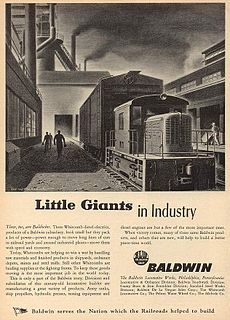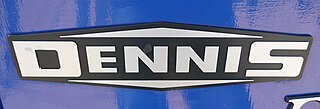
A diesel locomotive is a type of railway locomotive in which the prime mover is a diesel engine. Several types of diesel locomotives have been developed, differing mainly in the means by which mechanical power is conveyed to the driving wheels.

Under the Whyte notation for the classification of steam locomotives, 0-4-0 represents one of the simplest possible types, that with two axles and four coupled wheels, all of which are driven. The wheels on the earliest four-coupled locomotives were connected by a single gear wheel, but from 1825 the wheels were usually connected with coupling rods to form a single driven set.

The Tank, Infantry, Mk III, Valentine was an infantry tank produced in the United Kingdom during the Second World War. More than 8,000 of the type were produced in eleven marks, plus various specialised variants, accounting for approximately a quarter of wartime British tank production. The many variants included riveted and welded construction, petrol and diesel engines and a progressive increase in armament. It was supplied in large numbers to the USSR and built under licence in Canada. Developed by Vickers, it proved to be both strong and reliable.

A milk float is a vehicle specifically designed for the delivery of fresh milk. Today, milk floats are usually battery electric vehicles (BEV), but they were formerly horse-drawn. They were once common in many European countries, particularly the United Kingdom, and were operated by local dairies. However, in recent years, as the number of supermarkets, small independent grocers and petrol stations, and convenience stores stocking fresh milk has increased, many people have switched from regular home delivery to obtaining fresh milk from these other sources.

The Geo D. Whitcomb Company was founded by George Dexter Whitcomb (1834–1914), of Chicago, Illinois, who started a modest machine shop in 1878, and began the manufacture of coal mining machinery, laying the foundation for the concern that became known as The Whitcomb Locomotive Company.

Dennis Specialist Vehicles was an English manufacturer of commercial vehicles based in Guildford, building buses, fire engines, lorries (trucks) and municipal vehicles such as dustcarts. All vehicles were made to order to the customer's requirements and more strongly built than mass production equivalents. For most of the 20th century Dennis Brothers was Guildford's main employer.

Brush Traction is a manufacturer and maintainer of railway locomotives owned by the American company Wabtec Corporation, and based at Loughborough in Leicestershire, UK, and situated alongside the Midland Main Line.

Sentinel Waggon Works Ltd was a British company based in Shrewsbury, Shropshire that made steam-powered lorries, railway locomotives, and later, diesel engined lorries, buses and locomotives.

An electric truck is an electric vehicle powered by batteries designed to deliver cargo.

LMS diesel shunter 7050 is an experimental 0-4-0 diesel-mechanical shunting locomotive, introduced by the London Midland and Scottish Railway (LMS) in 1934 and which remained in service with that railway for six years. It was later acquired for military use and is now preserved at the National Railway Museum.

The British Rail Class 203, initially classified 6B, was a type of diesel-electric train. Seven units, numbered 1031-1037, were constructed in 1958 for use on the Southern Region. They were similar to the earlier Class 202 units, differing only in the substitution of a trailer buffet car for one of the three trailer second opens.

Richard Garrett & Sons was a manufacturer of agricultural machinery, steam engines and trolleybuses. Their factory was Leiston Works, in Leiston, Suffolk, England. The company was founded by Richard Garrett in 1778.

The Ipswich Transport Museum is a museum in Ipswich, Suffolk, England, devoted principally to the history of transport and engineering objects made or used in its local area.

Luna is a historic tugboat normally berthed in Boston Harbor, Massachusetts. Luna was designed in 1930 by John G. Alden and built by M.M. Davis and Bethlehem Steel. She is listed on the National Register of Historic Places and is a U.S. National Historic Landmark. In 1985, the Luna was designated as a Boston Landmark by the Boston Landmarks Commission.

The Eglin Air Force Base Railroad was a 45-mile military railroad at Eglin Air Force Base in Florida. It was created in 1951, and was operational until the late 1970s.

The Seattle trolleybus system forms part of the public transportation network in the city of Seattle, Washington, operated by King County Metro. Originally opened on April 28, 1940, the network consists of 15 routes, with 174 trolleybuses operating on 68 miles (109 km) of two-way overhead wires. As of spring 2016, the system carries riders on an average of 73,200 trips per weekday, comprising about 18 percent of King County Metro’s total daily ridership. At present in Seattle, a very common alternative term for trolleybus is trolley.

The 400 & 500 Class rail motors are diesel trains built by New South Wales Government Railways primarily for use on regional lines throughout NSW. The trains have since been phased out following a rationalisation of country branch line rail services in November 1983. The 400 Class power cars were built in 1938 at the Eveleigh Carriage Workshops, while the 500 Class trailer cars were built by Ritchie Brothers at Auburn.

Morrison-Electricar was a British manufacturer of milk floats and other battery electric road vehicles (BERV). Their first vehicle was built for a bakery in 1933, and the company ceased to exist when it was finally sold to M & M Electric Vehicles in 1983.

Midland Electric Vehicles was a British manufacturer of milk floats and other battery electric road vehicles between 1936 and 1958. They were based in Leamington Spa, and one of their major customers was Midland Counties Dairies, to whom they supplied just the chassis, with bodywork being built by the customer. At least two of their vehicles survive in museums.

Coventry Corporation Transport was the operator of trams and motorbuses in Coventry, Warwickshire from 1912 to 1974. The operations of Coventry Corporation Transport passed to West Midlands Passenger Transport Executive in the local government reorganisation of 1974.




















